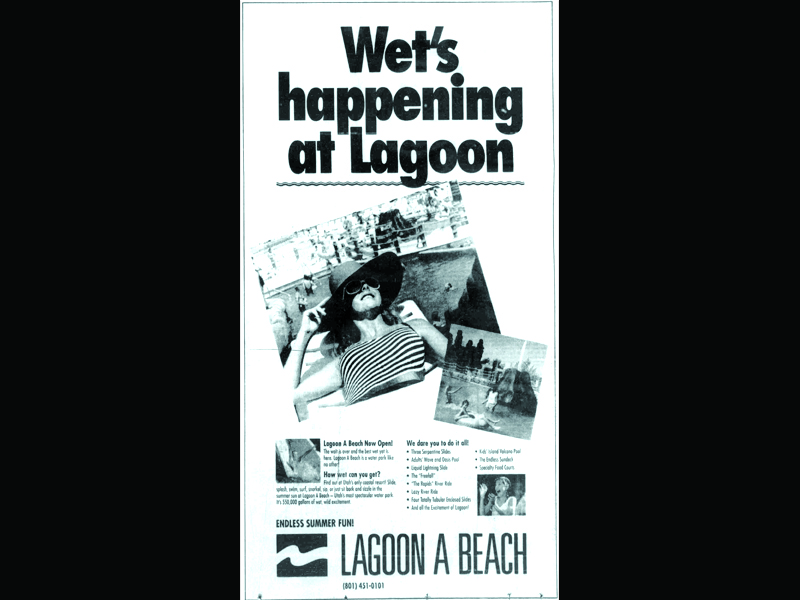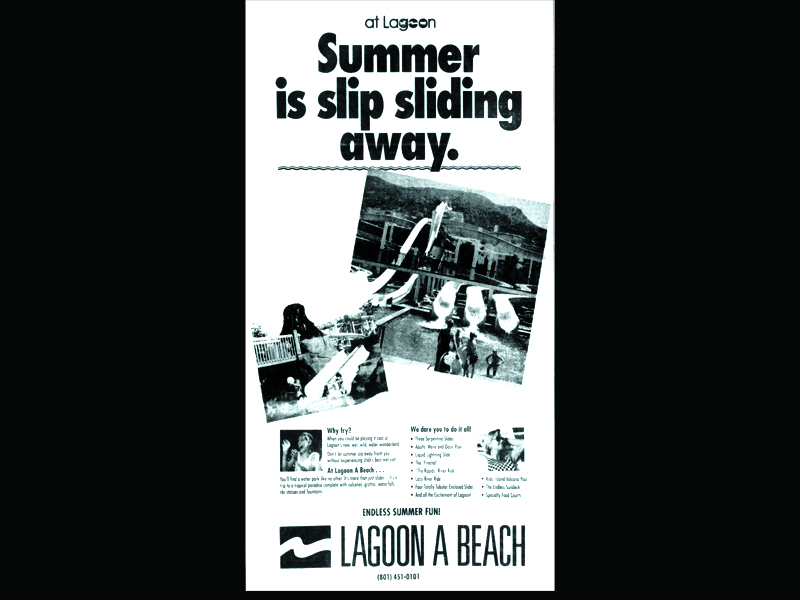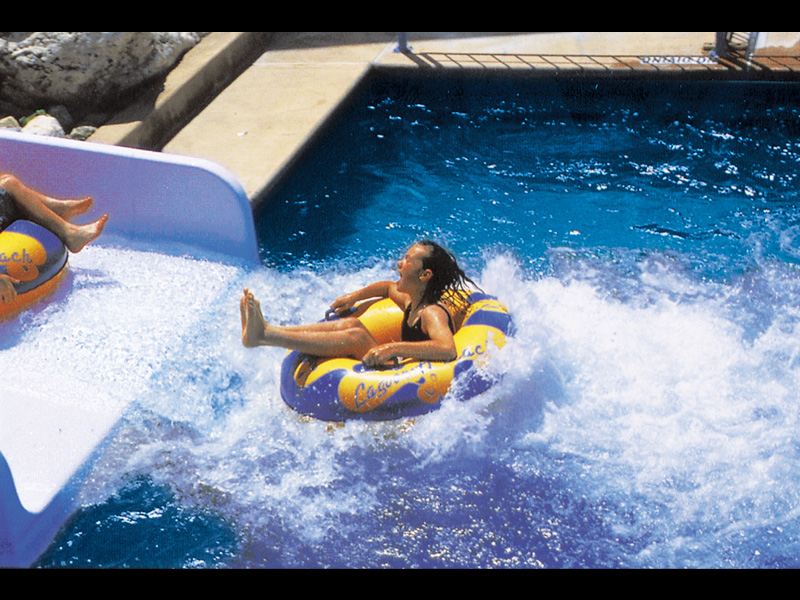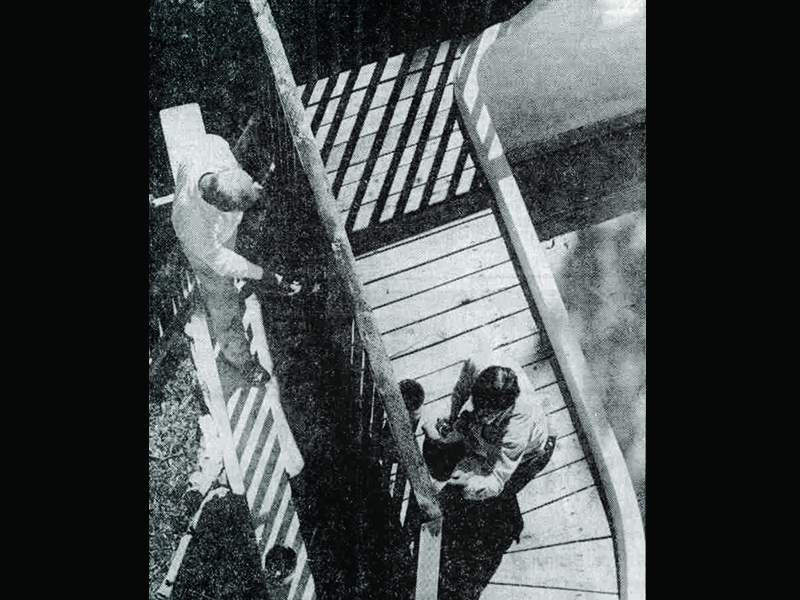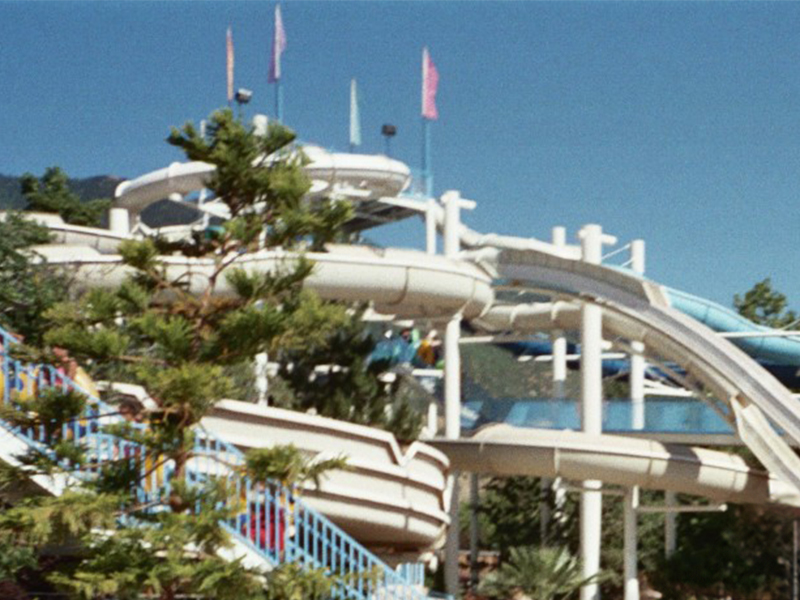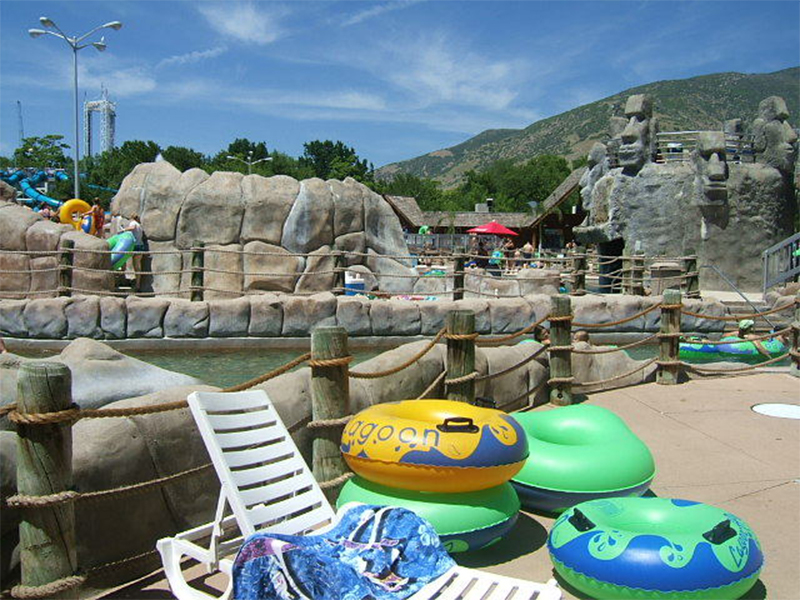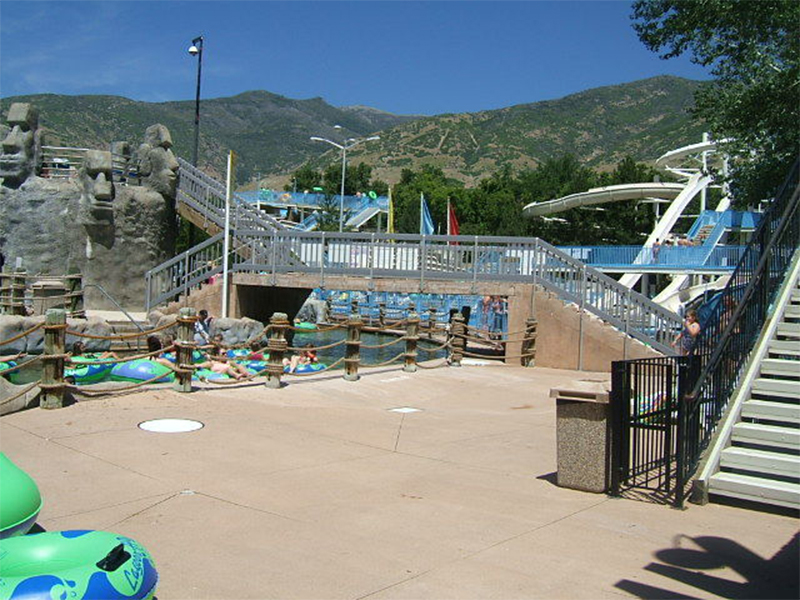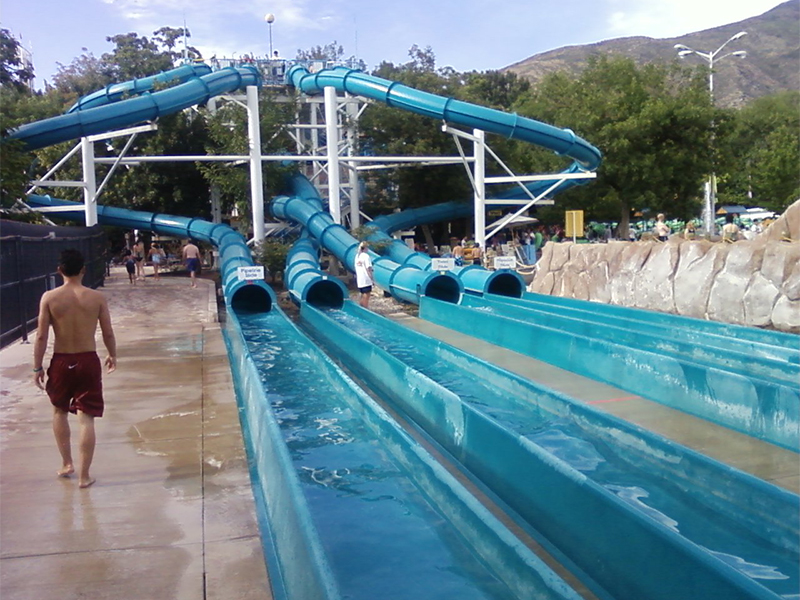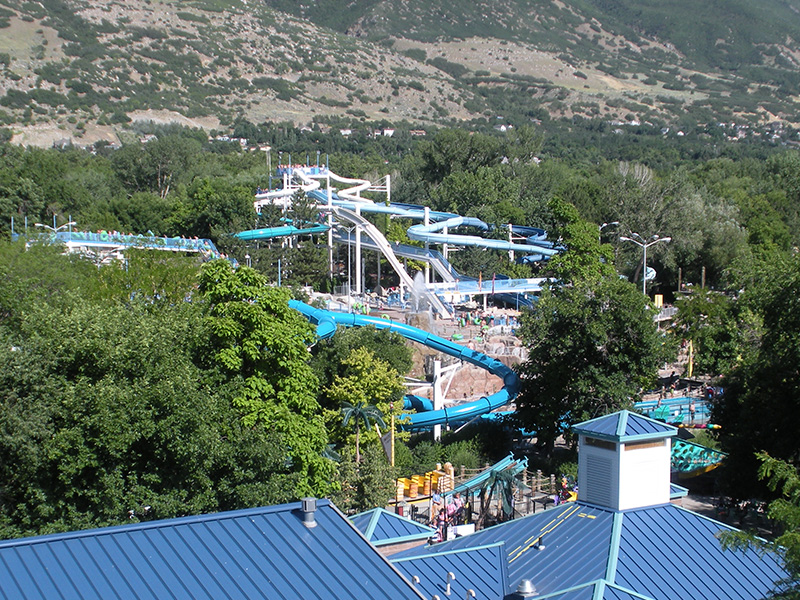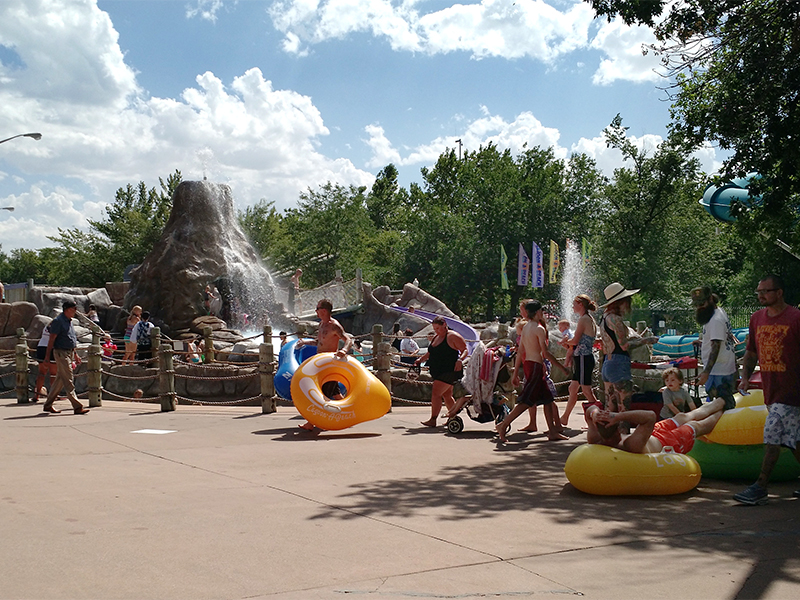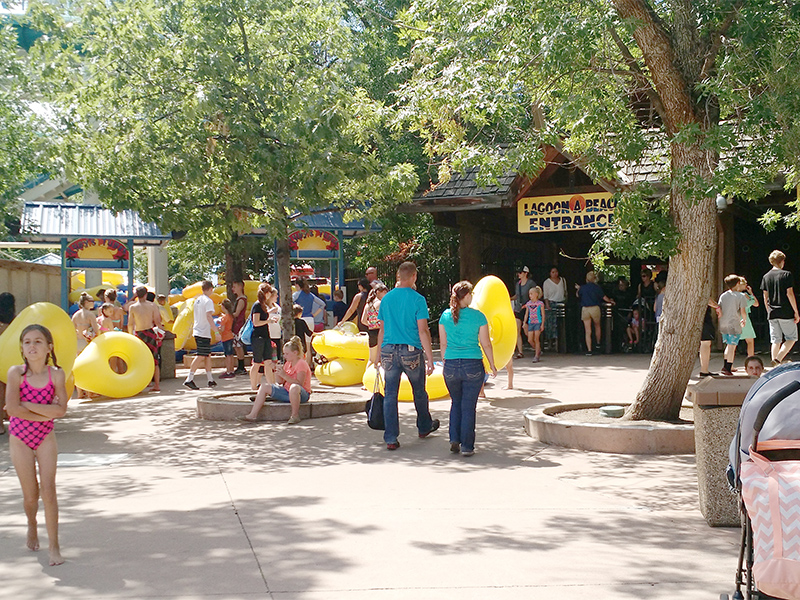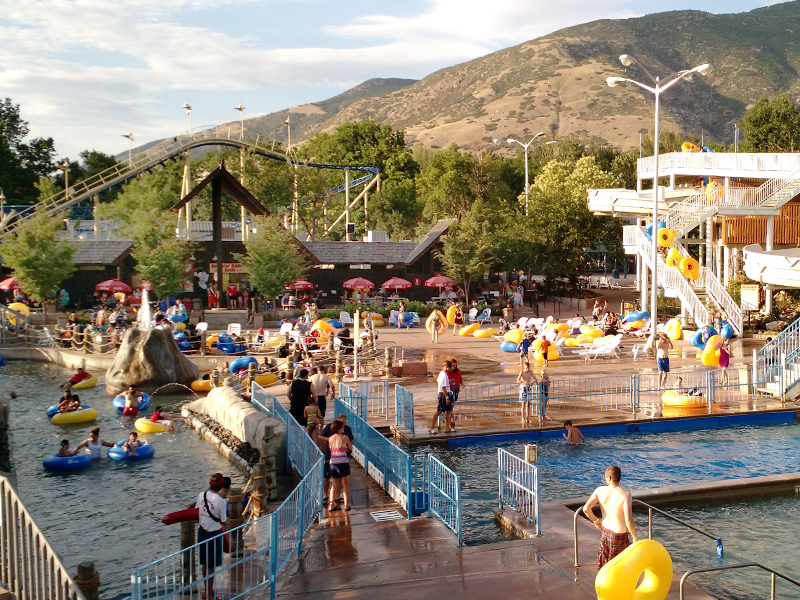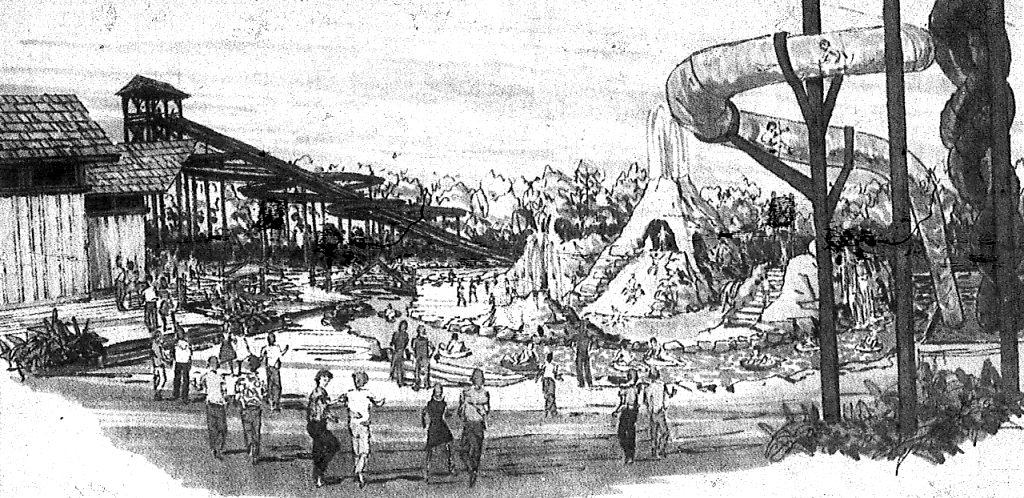
Opened: 9 Jul 1989
Designed By: Leisure And Recreation Concepts, Inc. – Dallas, Texas
Original Cost: $6,000,000
Area: 4½ acres
Number Of Slides: 10
Cooling off in the water has been a part of a day at Lagoon ever since it originated as Lake Park Bathing Resort, which opened in 1886 west of Farmington on the shore of the Great Salt Lake. After the lake’s water levels subsided far from the resort, the buildings were moved inland near a man-made “lagoon” where the park we know today as Lagoon opened in 1896.
At first there was simply a portion of the lagoon sectioned off for swimming. But numerous improvements were made over the years, like a modern, concrete-lined pool and top-of-the-line water filtering systems. In 1919, rail cars full of sand were brought in from California for a new Waikiki Beach next to the pool.

For decades, Lagoon’s pool was advertised as the largest filtered fresh-water pool in the West. But by the 1970s, modern swimming pools had become more prevalent across the Wasatch Front, making Lagoon’s pool less of a draw. It was also around this time that fiberglass water slides began popping up all over, bringing with them a wave of new activity centers called water parks. Lagoon once had various metal slides over the years, but fiberglass slides stayed much cooler and could easily be molded into unlimited configurations.
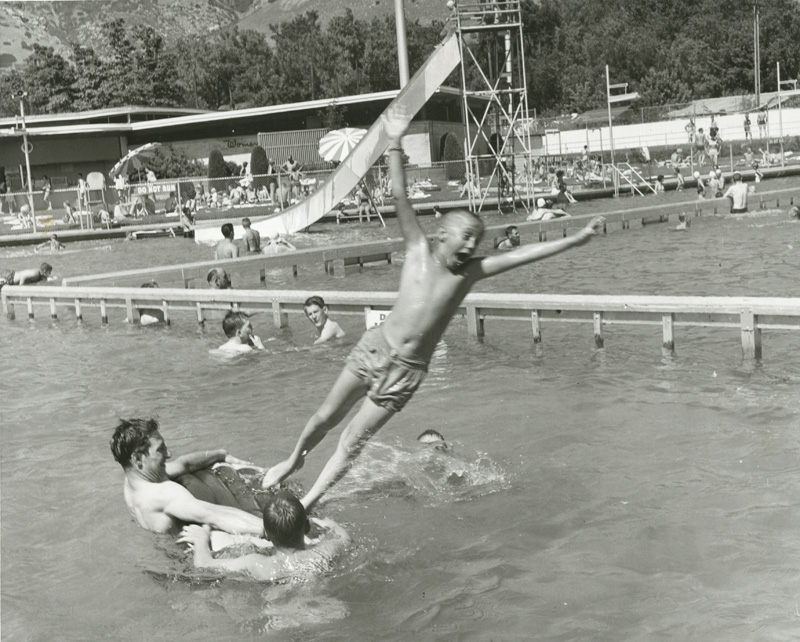
In Utah, the first of the new fiberglass water slides was reportedly the 30-foot-tall Kamikazi at Saratoga by Utah Lake. Then in 1979, Wild Waves opened in the Glendale area of Salt Lake City with the third wave pool to be built anywhere in the world. When Raging Waters acquired Wild Waves a few years later and started adding slides and other features, Lagoon noticed a drop in their overall attendance.
Flying J’s Wild Waters opened in Ogden in 1984 with another location in North Salt Lake. Just north of Lagoon in Kaysville, the Cherry Hill campground had also been adding water slides – two flume slides in 1980 and a river rapids-style slide in 1985. Smaller establishments with a single slide were also opening from Ogden to Draper and soon Lagoon’s swimming pool was no longer the refreshing rarity it once was. At the end of the 1987 season, Lagoon’s swimming pool closed for the last time. Over the next two years, it would be converted into an all-new water park.
BACK TO THE BEACH
Like Waikiki Beach 70 years earlier, the new water park would be named after a coastal locale. It was named Lagoon-A-Beach, a play on the name of California’s Laguna Beach. But the islands of the South Pacific would be the inspiration for the overall look and feel. Thematic elements from the Moai heads to the waterfalls, caves and volcanoes made Lagoon-A-Beach the most immersive setting at Lagoon since Pioneer Village was added in 1976.
To design the water park, Lagoon enlisted Leisure and Recreation Concepts, Inc. of Dallas, Texas. This design and consultation firm was founded by Michael Jenkins in the early ’70s after he helped with the creation of Six Flags Over Texas. LARC continues to work on theme parks, amusement parks and other projects around the world.
This major addition to the park warranted changes in how the park presented itself. In 1989, Lagoon introduced a new park logo for the first time in almost a decade. It would reflect the park’s major attractions – the rides of the Midway, the historic Pioneer Village and the “spectacular new water park”.¹
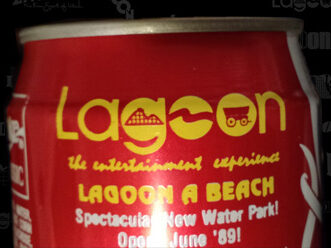
A new mascot was also created for Lagoon-A-Beach. Mooch was a surfing shark with shades and shorts and was the namesake of the lazy river, Mooch’s Mainstream (referred to as Paradise Canal in early press materials from 1989).
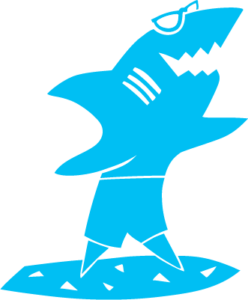
Long after he faded out of use at Lagoon-A-Beach, Mooch’s last appearance at the park was, oddly, alongside Puff, The Little Fire Dragon as part of the Hot Shots game on the Midway. The pair was painted over after 2015. Another symbol of the water park, a Moai statue, was used in Lagoon ads starting in 1992.

THE TOUR

Guests enter through a tall, octagonal entry/exit building with a clothing and gift shop called Rad Brad’s Surf Rags. After going through the building, the Beach House is straight ahead where you’ll find changing rooms, lockers, restrooms, first aid and food outlets.
There’s a total of ten water slides on three different towers. Next to Rad Brad’s is the Pipeline – four body slides that intertwine with each other. On the other side of the Beach House is the Outrigger – a tube slide with a series of pools along the way, intended to mimic river rapids. South of that is a tower with the Serpentine Slides on the 56-foot level and Speed Slides on the 65-foot level.
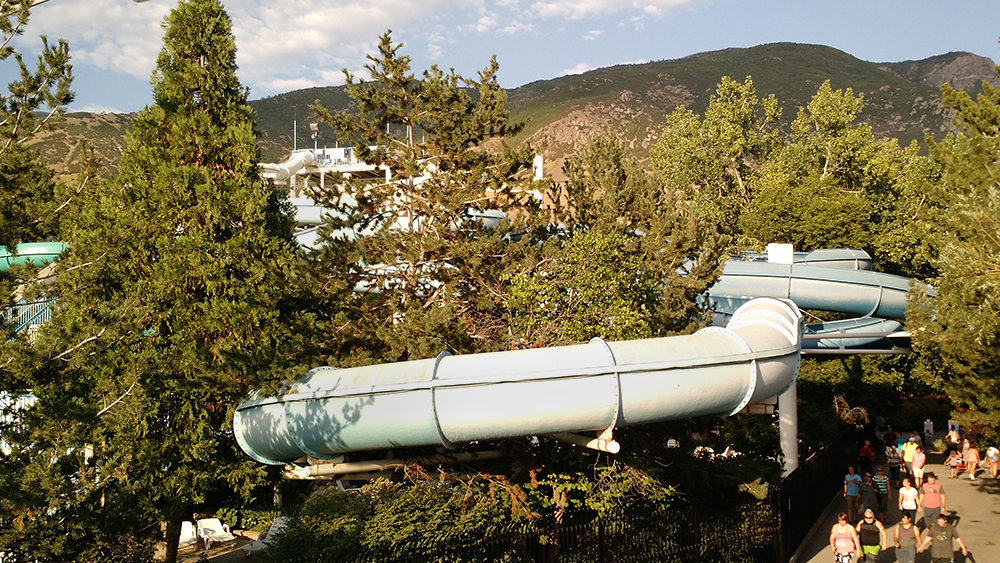
In the middle of it all is Mooch’s Mainstream, a lazy river which winds through fountains, a cave and around Bongo’s Bay and the Blue Lagoon. Bongo’s Bay is the kids’ area with a water-gushing volcano, slides, bridges and swings. The Blue Lagoon is an open swimming area with coves and waterfalls.
There are places to relax on lounge chairs above the cave, on a sun deck to the south and on grassy areas throughout the east side of Lagoon-A-Beach. There’s also a large, sand volleyball court near the Outrigger.
CLOSE QUARTERS
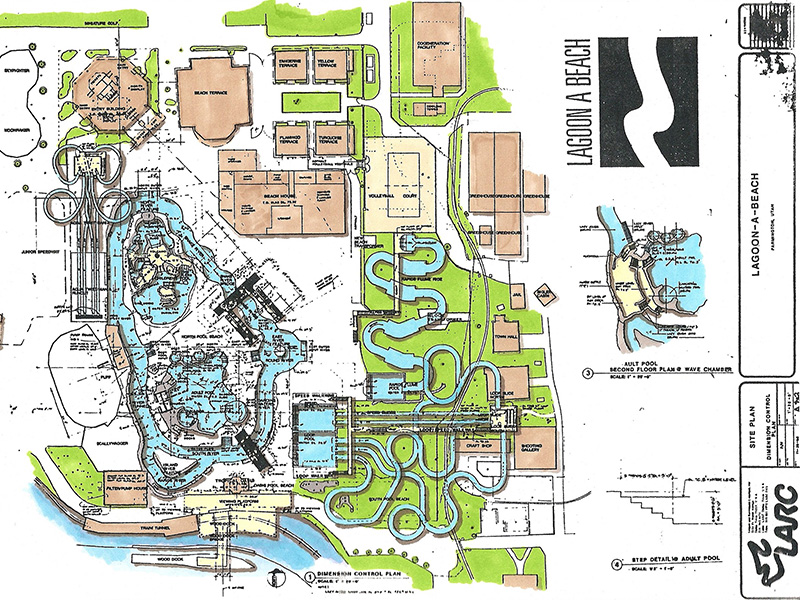
In order to fit all of this in a very limited space, several changes had to be made in the vicinity. The former Arbor Terrace was removed to make way for the entrance building and gift shop. Next to that was the large Beach Terrace, which remained in early plans and is shown on the 1989 guide map. But the need for more space arose between the planning and construction stages so it was either demolished before Lagoon-A-Beach opened, or shortly after.
Use the slider on the image below to compare Lagoon-A-Beach with the old Swimming Pool area.
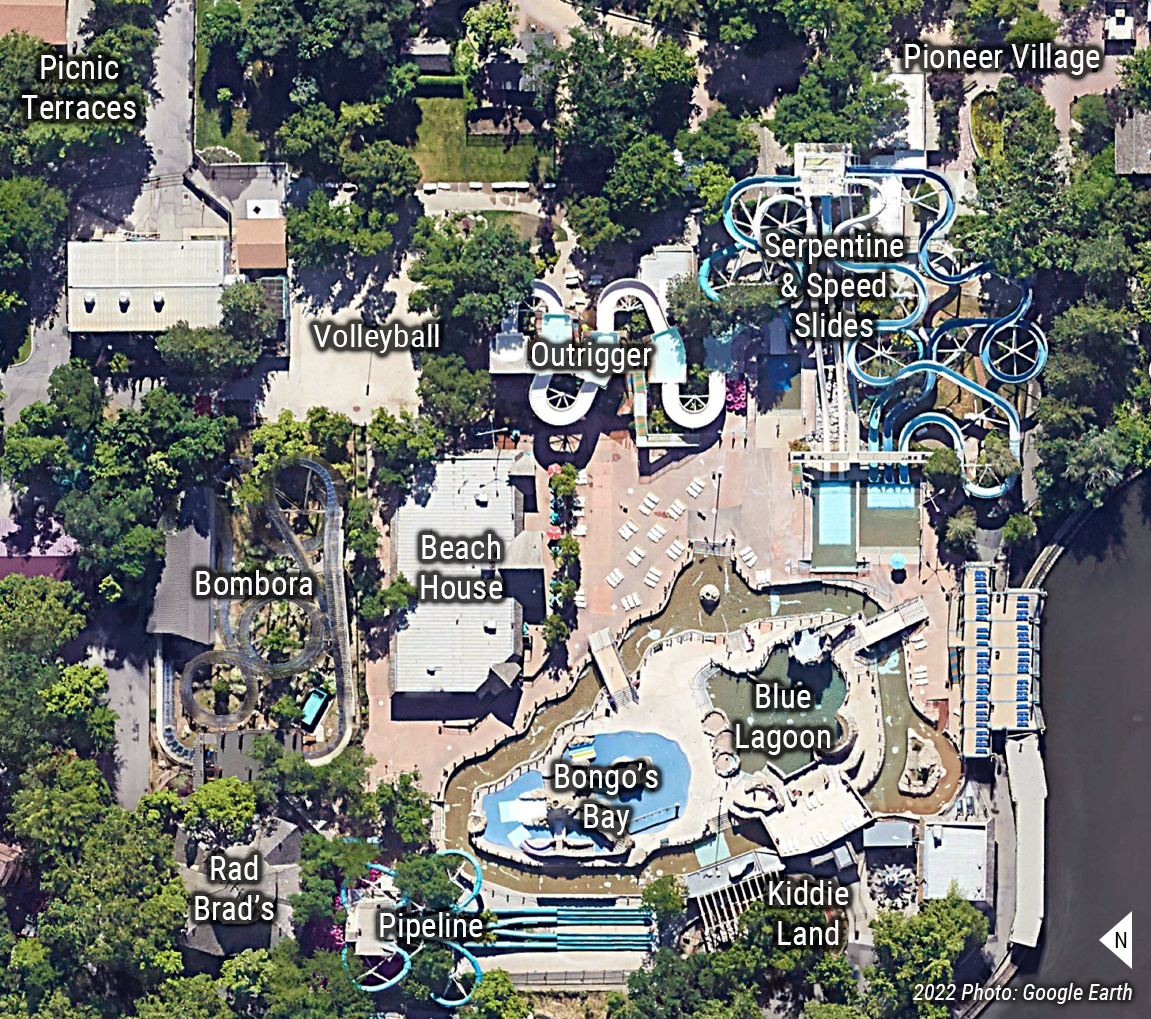
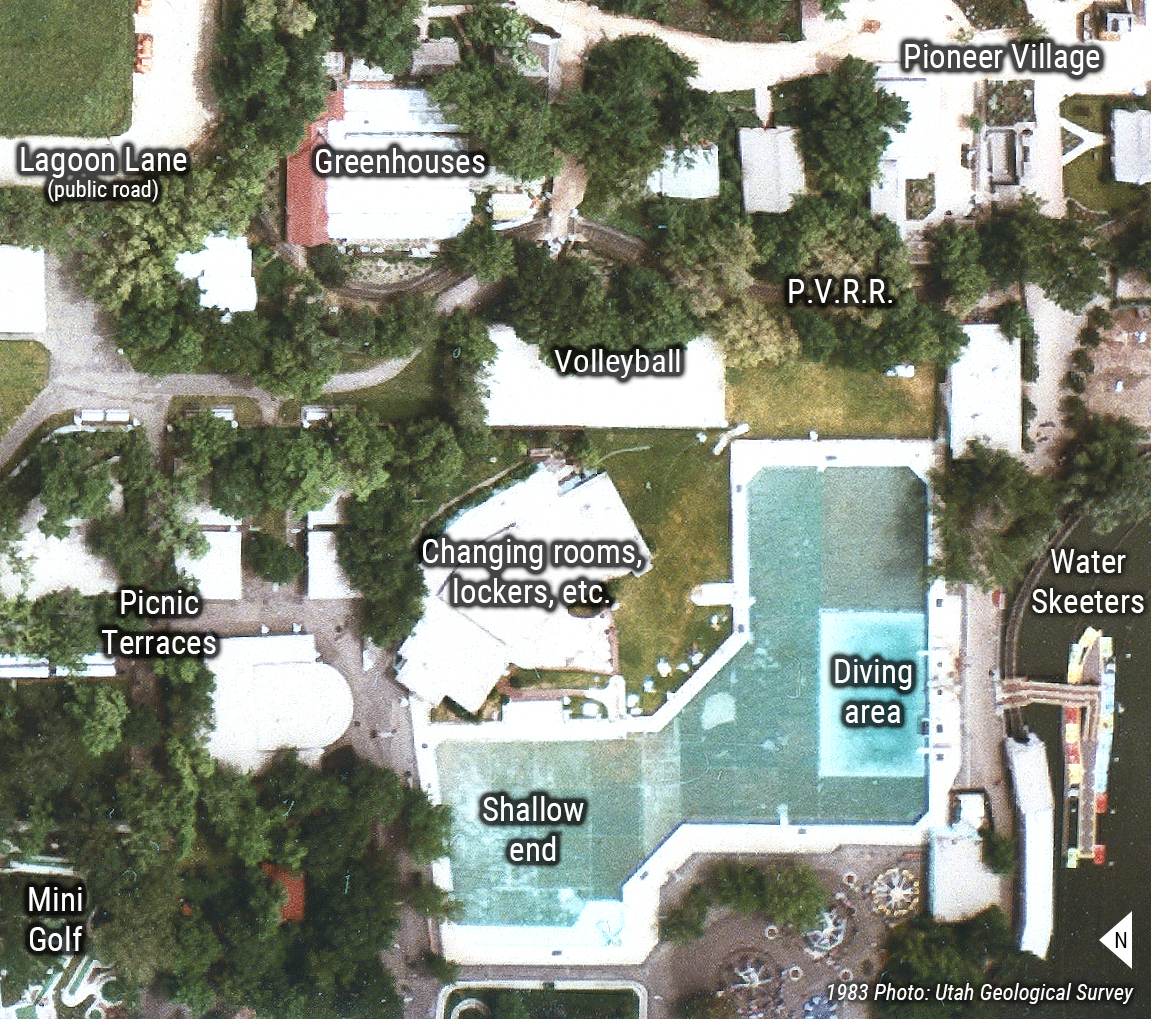
The Pioneer Village Railroad or P.V.R.R. circled the perimeter of Pioneer Village until 1988 when the stretch of track running between Pioneer Village and the pool was removed during construction. That portion was planned to be rerouted to run closer to the back of buildings in Pioneer Village and through supports for the new water slides.
Use the slider on the image below to compare the former P.V.R.R. route with the proposed path.
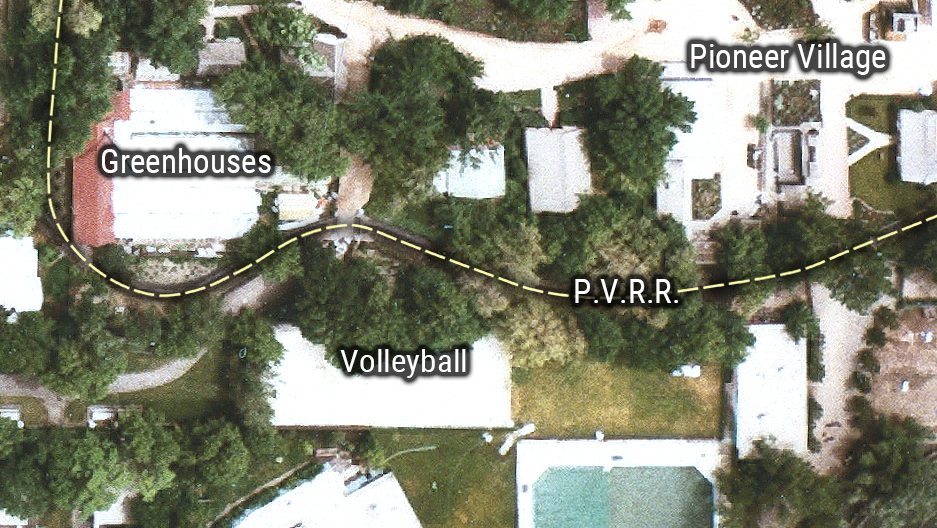
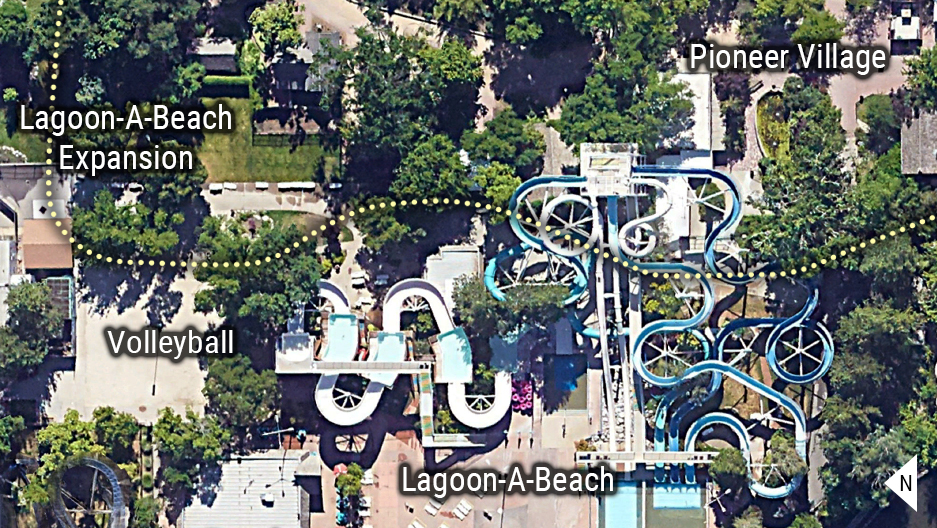
As mentioned earlier, even before Lagoon-A-Beach opened there was a concern that more space would be needed for guests to spread out than was originally expected. Without encroaching any farther into other areas of the park, the best option for more space would be to remove a group of greenhouses which had been standing east of the pool area for many years (see top left of comparison photos above).
The greenhouses were necessary for growing the flowers and other plants used to beautify an ever-growing park that was known for its gardens. So a new greenhouse was to be built on a small parcel of land owned by Lagoon on the other side of Pioneer Village, near Farmington’s Main Street. Since the land was zoned as residential, Lagoon’s request to build a greenhouse there had to go through the city’s planning commission, then to the city council and back to the planning commission before city officials decided in June 1989 to approve non-commercial greenhouses as a conditional use in that area.
In 1993, the expansion was complete and the area once occupied by the greenhouses is now a large, open lawn area with plenty of shade for putting out chairs or blankets away from the more active areas of Lagoon-A-Beach.
Unfortunately, this expansion may have also been the reason, or part of the reason, that the P.V.R.R. never returned.² It also meant that a former pathway that used to connect the north end of Pioneer Village to the rest of the park had to go too. This created a dead end in the Village and, along with the loss of the train ride, led to reduced foot traffic in Pioneer Village. These problems were remedied within a matter of years. When Lagoon expanded eastward³ it allowed for a new connecting path to improve circulation through Pioneer Village and the addition of Rattlesnake Rapids in 1997 brought crowds back to the area.
Once Lagoon-A-Beach began taking shape, the area would’ve been completely unrecognizable to the generations that grew up going to the old pool. There was one minor element that remained the same from the days of the Swimming Pool – the location of the pump and filtration building in the southwest corner by the Scalawags ride. But even that was remodeled to blend in with the new buildings.
MAKING WAVES
Planned to open on Memorial Day weekend in 1989, construction delays pushed back the opening of Lagoon-A-Beach to June, then July. Even after opening, well into August and the following off-season, many things were still being completed. But when Lagoon-A-Beach finally opened to the public on July 9th, Lagoon had quite the celebration.
The most unique part of the opening festivities was a fashion show by JCPenney. After featuring various styles sold by the national department store chain, a new clothing line debuted. The line was named Lagoon-A-Beach Togs and was designed by local artist Martin Blundell with a focus on durability to withstand sun, sand and water. In the months leading up to the grand opening of Lagoon-A-Beach, the collection of swimsuits, t-shirts, shorts and sweatshirts was sold at JCPenney stores in the area. After the opening, they were available exclusively at Rad Brad’s Surf Rags at Lagoon.⁴ Another fashion show was held the following May.

Even though the water park opened later than expected, Lagoon made the most of its short inaugural season. A beach party was held in August 1989, sponsored by KJQ (the radio station that became X96) with entertainment for the two-day event provided by the band Overboard and performances by Polynesian dancers. Instead of closing on Labor Day, as would become the custom, Lagoon-A-Beach stayed opened two whole weekends later in 1989.

Lagoon kicked off the water park’s first full season in 1990 with another party throughout Memorial Day weekend. There were performances by a steel drum band and a special show called Aqua Magic, created especially for Lagoon-A-Beach by a New York magician.
On two occasions in May and June 1990, the Federation of Outdoor Volleyball Association held men’s and women’s doubles tournaments at Lagoon-A-Beach’s new sand volleyball courts. It was co-sponsored by Mossimo, Oakley and Nordstrom.
The water park was equipped with enough lighting for night swimming, something other water parks in the region didn’t offer. And for at least couple of seasons in the early ’90s, there were Club Wet dance parties on Friday nights from mid-June to mid-August.
While there may not have always been regular entertainment at Lagoon-A-Beach, many remember the park’s famous marching bands making stops there, sometimes marching right into the lazy river. Also in the ’90s, there used to be an annual Rubber Duck Derby on Labor Day to help raise money for Make A Wish Foundation.
Before long, the benefits of the new water park were evident to park management. They found that more people were coming to Lagoon and they were staying at the park longer.

CHANGING TIDES
Although the overall experience and most of the features are relatively similar to when it opened, plenty of changes have taken place.
Initially, Lagoon-A-Beach had a separate admission price. Entry to the water park was $10.50. Along with the water park, you could walk the Midway and enjoy the shows, but rides were not included in a water park pass. However, there was a combination water park and ride pass for $20.95 (only five dollars more than the regular $15.95 ride pass at the time). Ticket windows for Lagoon-A-Beach were located in front of Rad Brad’s. By 1991, Lagoon-A-Beach admission was simply included as part of the regular ride pass and the ticket windows were no longer needed. Sometime around the late 2000s or 2010s, the ticket booth area was walled in and converted to a storage room.
One early feature of Lagoon-A-Beach were the water guns mounted in a few spots. They were a blast for the kids that used them, but not so welcome for their targets. Its unclear when they were removed, but it seems they were gone after only a few years.
Another original feature was a group of three hot tubs overlooking the Blue Lagoon. They were filled in and covered with concrete in 2009, but three stone rings still mark where they were located.
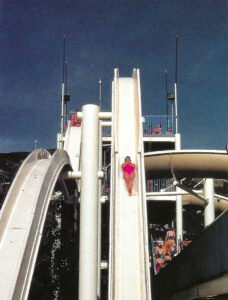
The two Speed Slides, or Drop Slides, were originally a straight shot right off the top of the 65-foot tower. But after finding some people would get too much speed, they were reconfigured. In the late ’90s, a curve was added to the first part of Liquid Lightning and in the early 2000s, the top of The Drop was moved to the south side of the tower with a few curves added to the beginning. The splash pool for these slides was built longer than was first planned, which is why the walkway between it and the lazy river is so narrow. The Serpentine Slides were all white at first, but have all been replaced at some point with blue slides that follow the same layout.
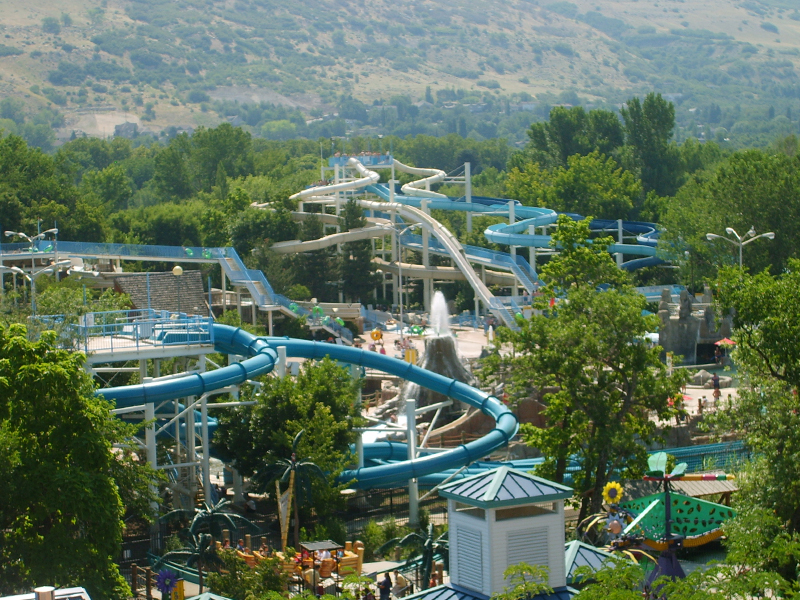
In the southwest corner of the Beach House was a small video game arcade, but like most arcades of the ’90s, it didn’t last. It’s currently part of the locker area. Other parts of the Beach House’s interior have also been renovated over the years.
While they’re not part of the water park, two nearby rides have borrowed the Lagoon-A-Beach aesthetic. The first was Kontiki, which opened near the Pipeline in 2004. It was named after a famous balsa raft used in a sailing expedition from Peru to the Polynesian Islands. The second ride was a surf-themed family coaster called Bombora, taking its name from an indigenous Australian term for large waves breaking over a reef or other shallow area.
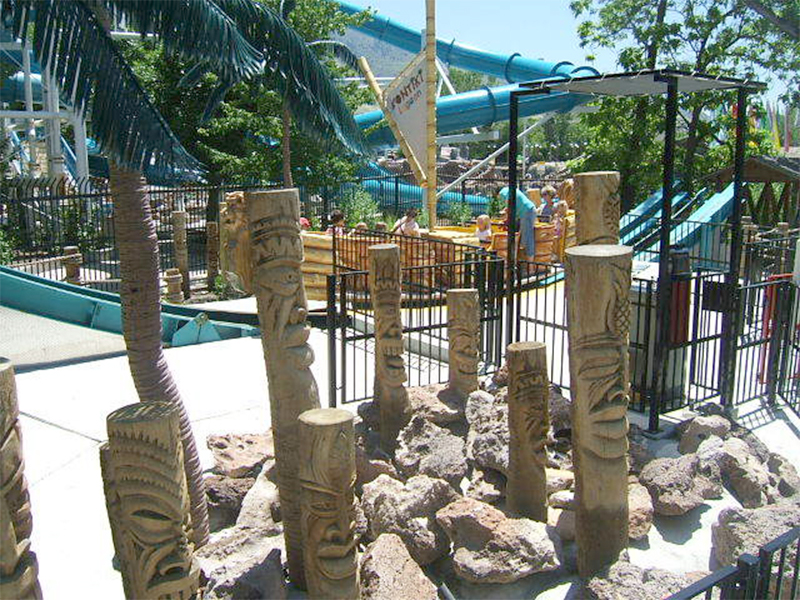
Bombora opened in 2011, north of the Beach House, but is only accessed from outside the water park. A group of four cinder block picnic terraces were removed to make space for the ride. For a while, two of the terraces were used for added locker space. All four terraces were removed in 2010, but trees were saved and the ride was built around them.

Ruby’s Tubes, the kiosks where inner tubes are rented and returned, also had to move for Bombora. The kiosks were north of the Beach House and relocated to south of Rad Brad’s. All of the tubes get replaced every few years or so, but the rental price has remained about the same.
Like the rest of the park, Lagoon-A-Beach allows guests to bring in their own food for picnicking, but also provides their own food offerings. In the front of the Beach House there’s a small food court, originally known collectively as Smokin’ Eddie’s Grill. Around 2016, one of the stalls became a Swig franchise (now Fiiz). One feature that was planned for the space in front of the south sun deck, which was never built, was a small, possibly cabana-style, drink and refreshment stand labeled as “Tropical Oasis”.
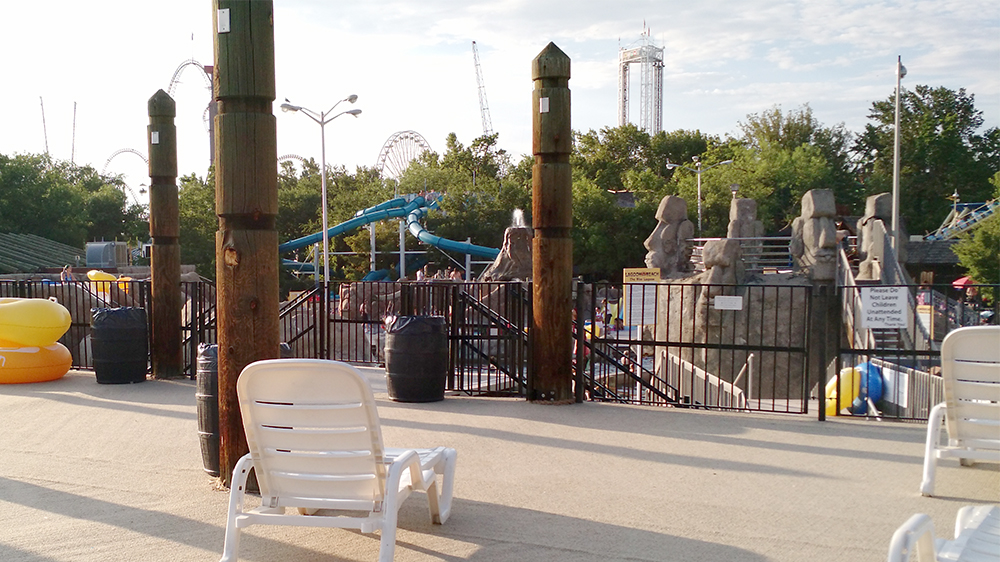
In recent years, the sun deck that overlooks the water park from the south end has had improvements such as special outdoor carpeting and shade sails. Other recent improvements at Lagoon-A-Beach include a new system for heating the water in 2020.
Lagoon’s operating season is about seven months long and Lagoon-A-Beach is only open for about half of that time. But not long ago, Lagoon began opening portions of the water park when the water isn’t flowing.
As part of Frightmares in 2018, a new walk-through for kids called Treat Street opened in the southeast corner of Lagoon-A-Beach. Then in 2021 they began using that walk-through as part of their traditional Easter festivities. For a weekend in spring, Treat Street becomes Bunny Boulevard with the added attraction of meeting the Easter Bunny for a photo op at the end.
Even though changes have been relatively minor and often go unnoticed by the average guest, Lagoon-A-Beach has outlasted most of the early competitors that caused Lagoon to add a water park in the first place. Saratoga closed in 1993. Wild Waters in Ogden was left vacant for years after several changes in ownership and has now been replaced by a Kenworth sales and repair shop. Raging Waters closed in 2018 and is now in the process of being transformed into a city park.
GALLERY
NOTES
1. You can read more about the evolution of the park’s logo here.
2. The path that the P.V.R.R. was supposed to take under the Serpentine Slides became a concrete walkway. Read more about the Pioneer Village Railroad here.
3. More information of Lagoon’s eastward expansion in the 1990s can be found on the Lagoon Trail page.
4. Find out more about Lagoon-A-Beach Togs and fashion photo shoots at the park here.
MORE FROM LHP
SOURCES
Lagoon press kit, 1989.
Lagoon newspaper ads, 1989.
Catch A Wave At ‘Lagoon A Beach’ Water Park. Deseret News, 9 Apr 1989.
Campbell, Joel. Lagoon: Utah’s Fun Spot aims to become ‘Family Entertainment Center’. Deseret News, 9 Apr 1989.
Lincoln, Ivan M. Lagoon A Beach: Resort is making waves this season. Deseret News, 21 Apr 1989.
Lagoon and Pioneer Village are opening for the season. Deseret News, 26 May 1989.
Hansen, Sheridan R. Seven Peaks water park splashes onto Utah scene. Deseret News, 28 May 1989.
Rosebrock, Don. Farmington OKs non-commercial greenhouses in residential areas. Deseret News, 25 Jun 1989.
Pedersen Budge, Rose Mary. Lagoon-A-Beach Togs are making a splash. Deseret News, 17 Jul 1989.
Lagoon readies for summer of fun. Deseret News, 30 Mar 1990.
Nickerson, James. Lagoon gears up for summer season. Lakeside Review, 15 May 1990.
‘Lagoon A Beach’ slides into park picture. Deseret News, 16 May 1990.
Lincoln, Ivan M. Utah water parks vying to make biggest splash. Deseret News, 25 May 1990.
Rosebrock, Don. Lagoon Legacy: Amusement park works constantly to offer new attractions. Deseret News, 16 Sep 1990.
Korosec, Thomas. The Walt Disney of Dallas. D Magazine, 28 Jun 2015.
The Cherry Hill Story. Cherry-Hill.com, accessed 25 Jul 2024.


